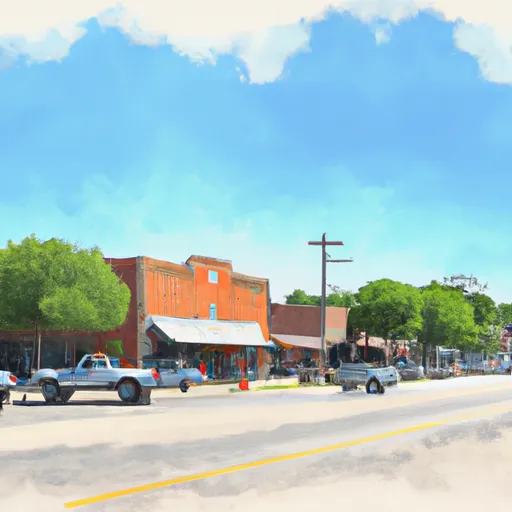-
 Snoflo Premium
Snoflo Premium
Get unlimited access to all our content
With no Ad interruptions! - Start Your Free Trial Login with existing account
Addington
Eden Index
Climate
9.7
•
Recreation
1.2
•
Community
•
Safeguard
4.3/10

Addington, Oklahoma is a small town located in Stephens County. The climate in Addington is characterized by hot summers and generally mild winters. The area receives an average annual rainfall of 36 inches, which contributes to the hydrology constituents of the region. Nearby bodies of water include Lake Waurika and the Red River. Outdoor recreation opportunities in Addington include fishing, hunting, and camping, as well as hiking and biking on local trails. Additionally, the town hosts an annual fall festival featuring live music, a parade, and various activities for all ages.
What is the Eden Index?
The Snoflo Eden Index serves as a comprehensive rating system for regions, evaluating their desirability through a holistic assessment of climate health, outdoor recreation opportunities, and natural disaster risk, acknowledging the profound impact of these factors on livability and well-being.
Climate Health Indicator (CHI): 9.7
Addington receives approximately
836mm of rain per year,
with humidity levels near 79%
and air temperatures averaging around
17°C.
Addington has a plant hardyness factor of
7, meaning
plants and agriculture in this region tend to thrive during the non-winter months.
By considering the ideal temperature range, reliable water supplies, clean air, and stable seasonal rain or snowpacks, the Climate Health Indicator (CHI) underscores the significance of a healthy climate as the foundation for quality living.
A healthy climate is paramount for ensuring a high quality of life and livability in a region, fostering both physical well-being and environmental harmony. This can be characterized by ideal temperatures, reliable access to water supplies, clean air, and consistent seasonal rain or snowpacks.
Weather Forecast
Streamflow Conditions
Red-Lake Texoma
Area Rivers
Red-Lake Texoma
Snowpack Depths
Red-Lake Texoma
Reservoir Storage Capacity
Red-Lake Texoma
Groundwater Levels
Recreational Opportunity Index (ROI): 1.2
The Recreational Opportunity Index (ROI) recognizes the value of outdoor recreational options, such as parks, hiking trails, camping sites, and fishing spots, while acknowledging that climate plays a pivotal role in ensuring the comfort and consistency of these experiences.
Access to outdoor recreational opportunities, encompassing activities such as parks, hiking, camping, and fishing, is crucial for overall well-being, and the climate plays a pivotal role in enabling and enhancing these experiences, ensuring that individuals can engage in nature-based activities comfortably and consistently.
Camping Areas
| Campground | Campsites | Reservations | Toilets | Showers | Elevation |
|---|---|---|---|---|---|
| Selma City Park - Lake Amon Carter | 21 | 920 ft | |||
| Kiowa Park - Waurika Lake | None | 979 ft | |||
| Clear Creek Lake | None | 1,181 ft | |||
| Lake Mineral Wells State Park | 105 | 875 ft | |||
| Wise County Park | 24 | 894 ft | |||
| Taylor Lake | 20 | 1,289 ft | |||
| Moneka Park - Waurika Lake | None | 906 ft | |||
| Wichita Ridge - Waurika Lake | None | 1,001 ft | |||
| Pelham City Park | 10 | 1,098 ft | |||
| Chisolm Trail Ridge - Waurika Lake | None | 975 ft |
Nearby Fishing
Nearby Ski Areas
Catastrophe Safeguard Index (CSI):
The Catastrophe Safeguard Index (CSI) recognizes that natural disaster risk, encompassing floods, fires, hurricanes, and tornadoes, can drastically affect safety and the overall appeal of an area.
The level of natural disaster risk in a region significantly affects safety and the overall livability, with climate change amplifying these risks by potentially increasing the frequency and intensity of events like floods, fires, hurricanes, and tornadoes, thereby posing substantial challenges to community resilience and well-being.
Community Resilience Indicator (CRI):
The Community Resilience Indicator (CRI) recognizes that education, healthcare, and socioeconomics are crucial to the well-being of a region. The CRI acknowledges the profound impact of these elements on residents' overall quality of life. By evaluating educational resources, healthcare accessibility, and economic inclusivity, the index captures the essential aspects that contribute to a thriving community, fostering resident satisfaction, equity, and social cohesion.

